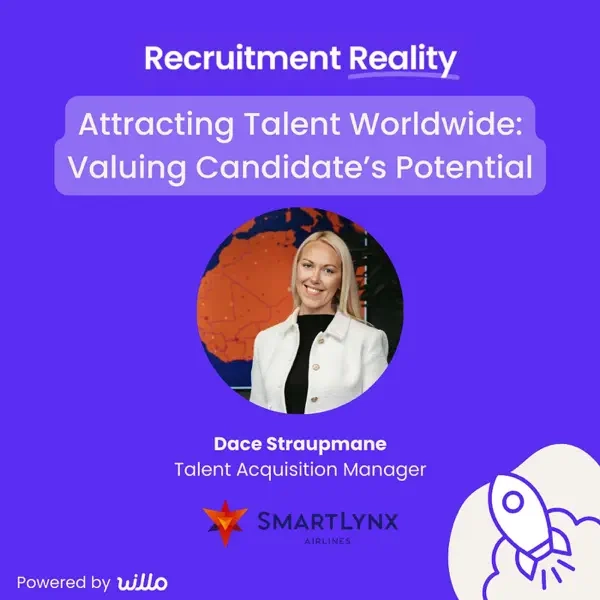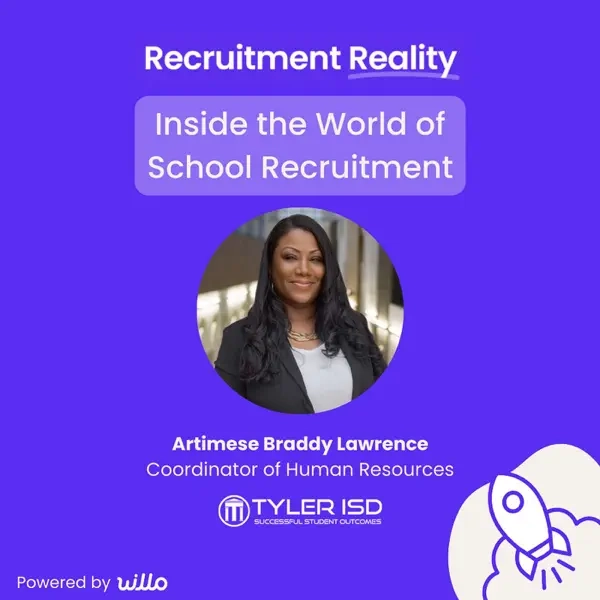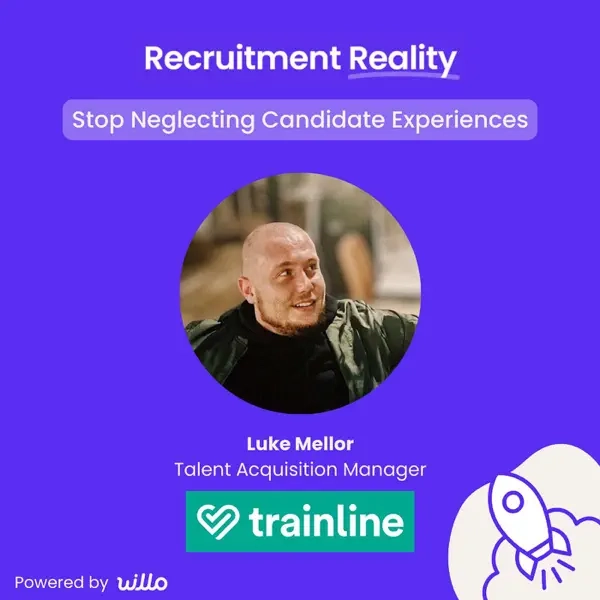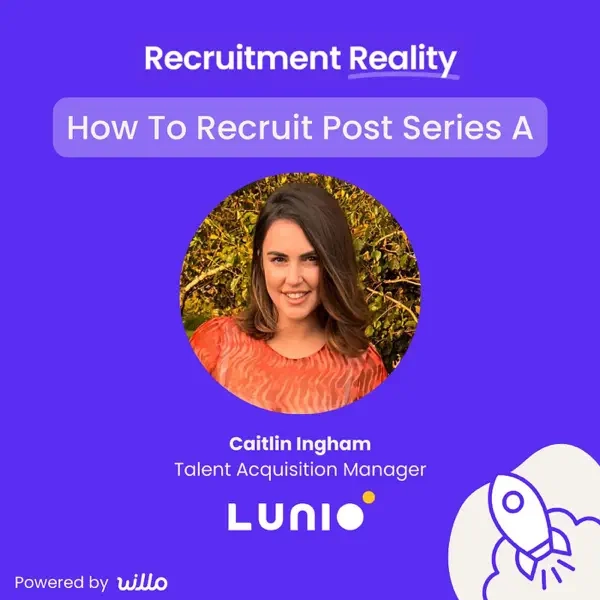Looking for recruitment process examples that show how companies actually hire—not just what they say they do? This article shares four real stories from hiring managers who joined us on the Looks Good on Paper podcast.
Each one faced a different challenge and found a practical way to solve it:
- SmartLynx hired people from outside aviation—including bankers—by focusing on skills and motivation, not job titles.
- Tyler ISD used video interviews to tell who was truly interested in the job and who just used AI to write their application.
- Trainline used automation to keep candidates informed at every stage, without losing the personal touch.
- Lunio focused on hiring people who bring something new to their culture, not just those who fit in.
Each example shows a different way to rethink your recruitment process—whether you’re short on candidates, swamped with applications, or trying to hire more thoughtfully. Let’s get into it.
#1. SmartLynx discovered aviation talents among bankers through skills-based recruitment
Talent Acquisition Manager, Dace Straupmane, shared a story about SmartLynx, an aviation company, on this episode of the Looks Good on Paper Podcast.
SmartLynx faced a global shortage of qualified engineers and pilots, roles that often require years of specialized training. As a brand that operates behind more well-known airlines like EasyJet, they also face challenges in standing out and attracting talent in a competitive market.
To tackle these issues, SmartLynx shifted to a skills-based recruitment approach, prioritizing potential and motivation over traditional, industry-specific experience. Here's what they did:

- Tapping into overlooked talent pools: They actively engage with universities, offering internships and junior roles to find and grow new talent within the company. Crucially, SmartLynx positions itself as a workplace where an aviation background isn't always required—particularly for non-technical roles like operations.
- Prioritizing motivation and soft skills: Instead of focusing on industry qualifications, they look for strong English skills, a willingness to learn, and a drive to grow—especially from candidates transitioning from other sectors.
- Using tech to assess fit: SmartLynx implemented Willo’s pre-recorded interviews to evaluate candidates’ motivation and personality. Applicants recorded a short video pitching why they wanted to join SmartLynx—giving the hiring team a clearer view of their enthusiasm and potential, beyond what a resume could show.
This strategic shift has led to so many interesting hires at SmartLynx. Crucially, some applicants successfully transitioned from banking to aviation and thrived due to their strong motivation and adaptability.
Additionally, many of the interns who were paired with an experienced mentor have even gone on to become key employees holding senior positions and spreading the word about SmartLynx’s positive work culture.
Listen to the full story on the Looks Good on Paper podcast.
#2. Tyler ISD uses pre-recorded videos to cut through AI-generated applications
Coordinator of Human Resources at Tyler ISD, Artimese Braddy Lawrence shared a story of how Tyler ISD uses video interviews to identify candidates who are genuinely interested in the role.

Initially, the recruiting team noticed that applications looked polished but felt AI-generated: similar phrasing and polished formatting, but lacking real substance. This made it harder to distinguish between truly motivated candidates and those who just used the right words in their applications.
To cut through that noise, Tyler ISD implemented Willo for asynchronous candidate screening. Early in the process, candidates respond to structured video questions, allowing the team to:
- Interact directly with candidates and confirm if they match what’s on their resume.
- Gauge their motivation and long-term interest in the role.
- Quickly narrow the applicant pool.
Top candidates then move on to a live interview with a supervisor or panel—a chance to dig deeper and spot those in it for a career, not just a job.
This approach helps Tyler ISD focus on hiring people who are genuinely committed to a future in education.
Listen to the full story on the Looks Good on Paper podcast.
#3. Trainline enhances the candidate experience with automated and personalized communication
Talent Acquisition Manager at Trainline, Luke Mellor, shared a story of how the company personalizes emails sent to candidates, regardless of the number of applicants.

When you're hiring for a senior role and 50 applications roll in every day, something has to give. For most companies, that “something” is the candidate's experience.
Responses slow down. Personalization drops off. And people get ghosted.
But that's not the case with Trainline.
Luke Mellor, Talent Acquisition Manager, always knew that offering a fully bespoke journey to every candidate wasn’t practical, especially when hiring at scale.
So, instead of using that as an excuse to undermine the candidate experience, he uses automation to send personalized emails at every step of the recruitment process.
Before a job goes live, Luke programs interview plans, email nurture sequences, and message templates into the ATS. With a single click, he sends out personalized messages to candidates 24-48 hours after each stage, to keep them engaged with the recruitment process.
Even better, Trainline goes beyond the basic first-name personalization. They also include relevant information that paints a picture of what it’s like to work in the company. Think:
- A LinkedIn post from the CTO about an offsite in Paris
- The CEO’s H1 update to reassure candidates during market uncertainty
- A curated roundup of company milestones and values
These messages help candidates picture themselves at Trainlinez and feel genuinely welcomed. Even if they don’t get the role, they walk away with a positive perception of the company. In fact, a candidate who didn’t get the job felt so respected that they stayed in touch and were successfully hired in a later round.
So, how can you implement this?
- Think like a marketer or salesperson. Just as sales teams nurture leads with relevant, well-timed content, your recruitment process should do the same for candidates.
- Include content relevant to the stage the candidate is in the recruitment process. Suppose a candidate has just submitted their application. You can send a welcome message with a link to your careers blog or company values page.
- Consider what’s on candidates’ minds, and tailor your content to address those concerns. For example, if job security is a common worry (especially in uncertain economic times), share content that highlights your company’s financial stability, like recent performance results. This helps build trust early in the process.
Listen to the full story on the Looks Good on Paper podcast.
#4. Lunio builds inclusive teams by hiring for culture add, not culture fit
Caitlin Brown, People Manager at Lunio, shared how the company builds a more inclusive and values-aligned team by focusing on what each candidate adds to the culture, rather than how well they "fit in."

After a series A fundraise, Lunio wanted to double its headcount in 12 months. But they wanted people who expanded the company culture, not fit into it.
To achieve this, they revamped their recruitment process to prioritize culture-add over culture-fit. Rather than “Will this person fit in?”, they asked, “What will this person bring that we don’t already have?” That meant welcoming people from different industries, experiences, and backgrounds.
How did Lunio do this?
- Structured interview questions: In early interviews, all candidates are asked the same questions about their journey, strengths, and personal values. This prevents interviewers from going off-topic and uncovering shared interests that could lead to affinity bias.
- Involving senior executives in the recruitment process: In the final stage, candidates meet Lunio’s founders. They hear the real story behind Lunio, straight from the people who built it, and can decide for themselves if it’s a place they want to grow.
- Using technology to surface traits: Lunio uses Willo to implement pre-recorded video interviews in its recruitment process. This gives candidates a chance to showcase their personality and motivation in ways they can't do in a CV.
This change in hiring philosophy has helped attract talent that brings new dimensions and perspectives to Lunio, rather than simply replicating existing profiles.
Listen to the full story on the Looks Good on Paper podcast.
Want more ways to improve your recruitment process?
The four stories above show how real companies solved specific challenges—from cutting through AI-written applications to hiring for culture-add.
But they’re just the beginning.
If you’re looking for a broader set of ideas to improve your hiring in 2025, check out our recent hiring guide: 6 Ways to Improve the Recruitment Process in 2025
It covers:
- Common recruitment challenges (and how to solve them)
- Proven ways to create a better candidate experience
- Tips for using automation and structure without losing the human touch
Perfect if you’re short on candidates, swamped with applications, or just want to rethink your hiring from the ground up.



%20(1).webp)